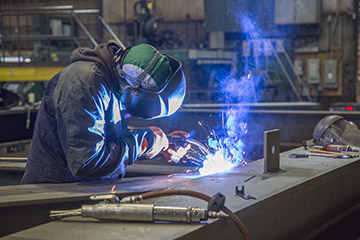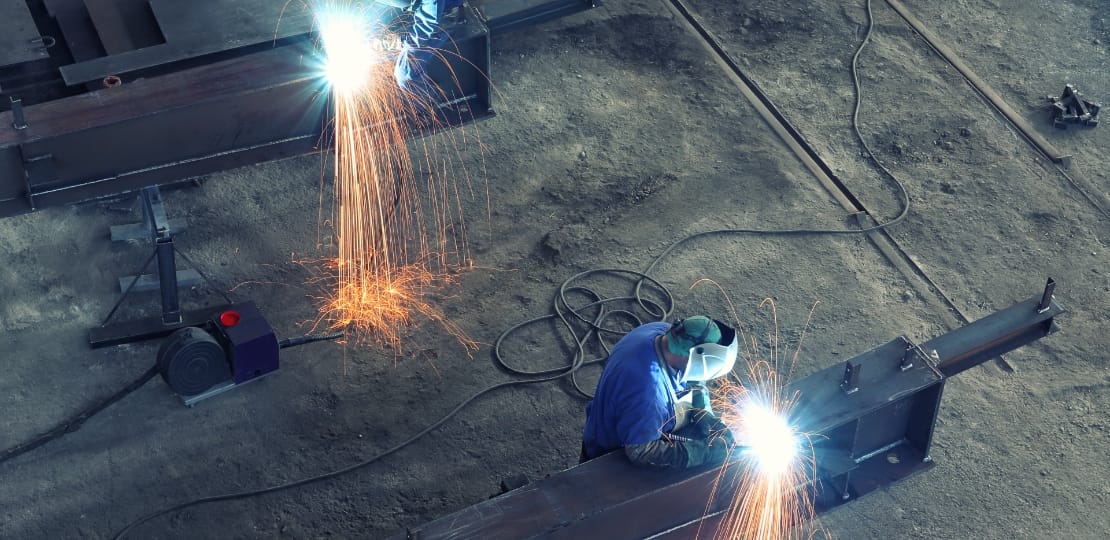Field vs. Shop: What’s the Best Welding Process for Structural Steel Fabrication
Structural steel fabricators face challenges on every job — from making accurate bids to maintain their competitiveness to meeting project deadlines and code requirements, passing inspections and implementing effective operator training.
Choosing the best welding process and filler metal for welding structural steel is key, regardless if the application is a bridge, building or other such project. It helps ensure that fabricators achieve the greatest efficiencies and best quality in their operations.
First consider whether the structural steel welding will take place in an indoor shop setting or outdoors in the field, as this factor alone either introduces or eliminates a host of elements — including wind, the enemy of shielding gas and the welding processes that rely on it.
Stick welding and self-shielded flux-cored arc welding (FCAW-S) processes are most commonly used for structural steel applications in the field while gas-shielded flux-cored arc welding (FCAW-G) and submerged arc welding (SAW) are used for indoor structural steel welding. MIG welding with solid and metal-cored wires is used in the shop as well, but not nearly as widely as FCAW-G.
Fabricators should weigh the pros/cons of these welding processes and select the option that is best suited for their application. For example, for field applications decide between the portability and simplicity of stick welding versus the productivity of FCAW-S. For shop welding, the flexibility of FCAW-G, the cleanliness of MIG (solid or metal-cored) or the productivity of SAW are all factors to consider.
Filler metals and processes for field applications
While operators often use stick welding for outdoor jobs, changing to FCAW-S can dramatically improve productivity. Stick welding is a familiar process that is more portable, which is why welding operators often prefer it — especially if the application requires them to move around a lot. But it is also a notoriously slow one, due to frequent stick electrode changeovers (electrodes are consumed approximately every 12 inches and must be replaced). That’s why, when a field application has a large amount of welding in a single location, several large and/or multi-pass welds, it could be much more productive to convert to a FCAW-S wire.
At the end of the day, choosing the right process for a field application depends on how much time will be spent welding versus how much time is spent relocating. If the operator is mostly stationary during an outdoor application, FCAW-S should be considered to boost productivity. If not, it might be wisest to stay with the stick welding process.
If a changing welding process is desired, the fabricator may need to re-qualify the welding procedures for the application. Although this takes both time and effort, it can be worthwhile given the long-term cost savings through productivity increases. In structural welding applications, it is common to use “pre-qualified” welding procedures that require much less testing, minimizing this potential hindrance.
In some cases, it may be most effective to qualify and use both stick welding and FCAW-S on the same job. The areas that require minimal welding can use stick welding to enjoy the portability advantages and leave the heavy welding areas for FCAW-S where the higher welding productivity process will shine.
Other considerations include:
Hydrogen levels: Most American Welding Society (AWS) 7018 stick electrodes, which are the most widely used, have low diffusible hydrogen levels (4ml per 100g or H4 is common). The FCAW-S wires are H8 (8ml per 100g) or higher; H4 is not available.
Power sources: FCAW-S should be used with a constant voltage (CV) power source. Depending on the classification of the wire, it may require DCEN or DCEP polarity. DCEN is more common but not used for all FCAW-S wires. In many cases, an operator may already have a multi-process machine capable of these settings. If not, a CV-capable power source needs to be purchased.
Training: FCAW-S wires have distinct characteristics and operating requirements depending on the AWS classification (type of wire), including specific voltage and stick-out (electrode extension) settings. These wires require the use of specific gun angles and travel speeds to achieve the best weld quality, too. Training for welding operators without FCAW experience is important.
Filler metals and processes for shop applications
For structural steel applications in the shop, FCAW-G wire is common, due to its ease of use and all-position capabilities. These features make it usable by welding operators of varying skill levels. These wires typically have very large parameter windows in which they operate very well, and they are very forgiving to incorrect and or inconsistent technique. FCAW-G wires also can weld on dirtier base metal conditions, such as the mill scale found on hot rolled steel — a common occurrence in structural fabrication. Lastly, these wires are capable of high deposition rates.
The extra activities associated with the process, however, can cut into overall productivity. FCAW-G wires produce slag, which must be removed in between passes and after welding. This slag can easily accumulate on the shop floor, equipment and fixtures, leading to additional cleaning.
In some welding applications, MIG welding can be used instead of FCAW-G and can eliminate non-value-added activities in the shop. Since MIG welding doesn’t generate slag, post-weld activities such as grinding or chipping are not necessary — saving labor, time and money.
There are some drawbacks to MIG compared to FCAW-G. It is not as easy to use or forgiving to the welding operator, and is more difficult and slower to weld out of position. It is also less capable of welding through mill scale.
Filler metals available for MIG welding include solid wire and metal-cored (or composite) wire. Metal-cored wires address some of the drawbacks listed above. They are more forgiving to welding operator technique, making them easier to use. This feature results from the broad and very fluid weld pool that is common with these wires. Metal-cored wires also operate over a larger range of parameters, making it easier for welding operators to set the power source. Lastly, these wires contain higher levels of deoxidizers (cleaning elements) that allow them to perform better on mill scale or dirty base metal.
The SAW process is used to maximize productivity on structural steel applications in the shop that require long, continuous and possibly multi-pass welds, such as those found on an I-beam. While SAW requires a larger capital expense upfront, it also provides the highest productivity rates. The investment can pay off quickly if a structural application requires a lot of arc-on time.

non-value-added activities in the shop. Since metal-cored wire
doesn’t generate slag, post-weld activities such as grinding or
chipping aren’t necessary, saving labor, time and money.
SAW can use solid or metal-cored wires also. The tubular construction of the metal-cored wire results in higher deposition rate at the same amperage as a solid wire, increasing travel speeds to make the same size weld. This, in turn, improves productivity and reduces heat input, which can minimize the need for costly straightening operations.
For example, an 1/8-inch diameter SAW solid wire used at 100 wire feed speed (wfs) and 30 volts would result in 650 amps and travel at 22 inches per minute (ipm) to get a determined weld size of “X”. Whereas, a 1/8-inch metal-cored wire used at 650 amps would require 150 wfs, 30 volts and must travel at 27.5 ipm to produce the same weld size of “X”. This means that the SAW process with the metal-cored wire increased travel speed 25 percent and reduced heat input 25 percent. For a structural steel welding scenario, that welding productivity gain, along with the heat input reduction that can minimize post-welding activities, can add up to big savings.
Since labor is the largest cost in any welding operation, even gaining a small reduction in cycle time can provide huge savings in the long run. This can come from an increase in deposition rate, which would reduce time spent welding, or from reducing/eliminating non-welding activities like grinding, post-weld cleaning, straightening beams, etc.
Final thoughts
In any application, quality, productivity and cost savings are critical to operating an efficient and profitable welding operation. The welding of structural steel, whether in the field or in a shop, requires the same care and attention. To gain the best results, fabricators should ask themselves “Am I using the right process?” If opportunities for improvements exist or problems have occurred, it may be worthwhile to consider a new filler metal and process for the job.



